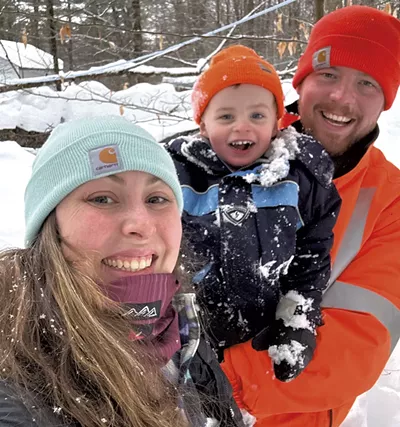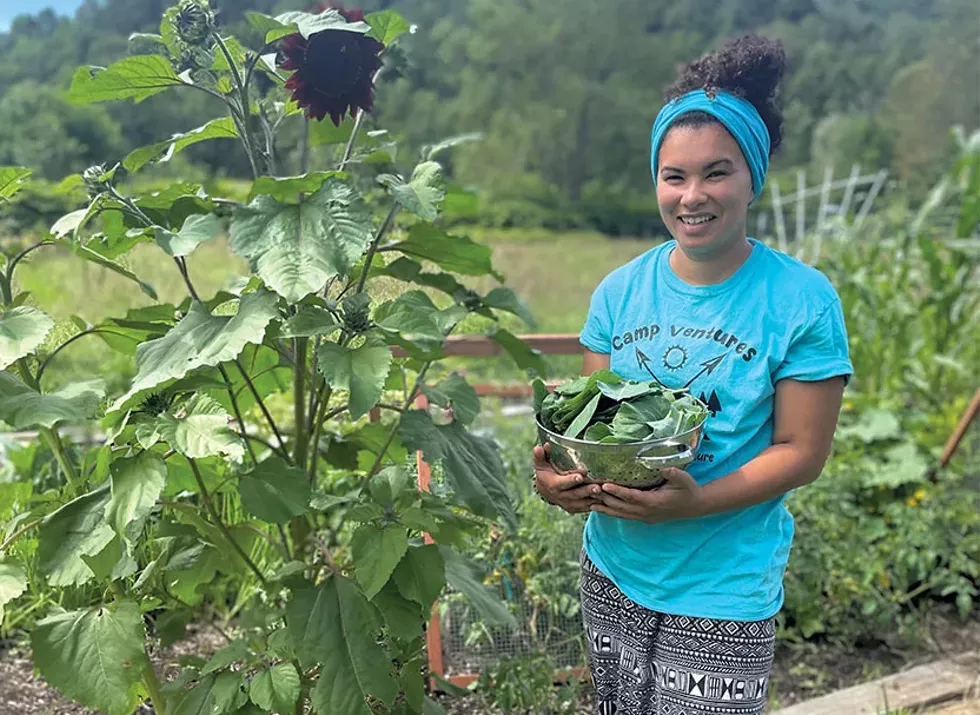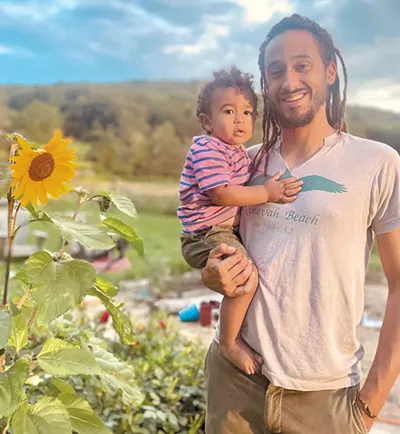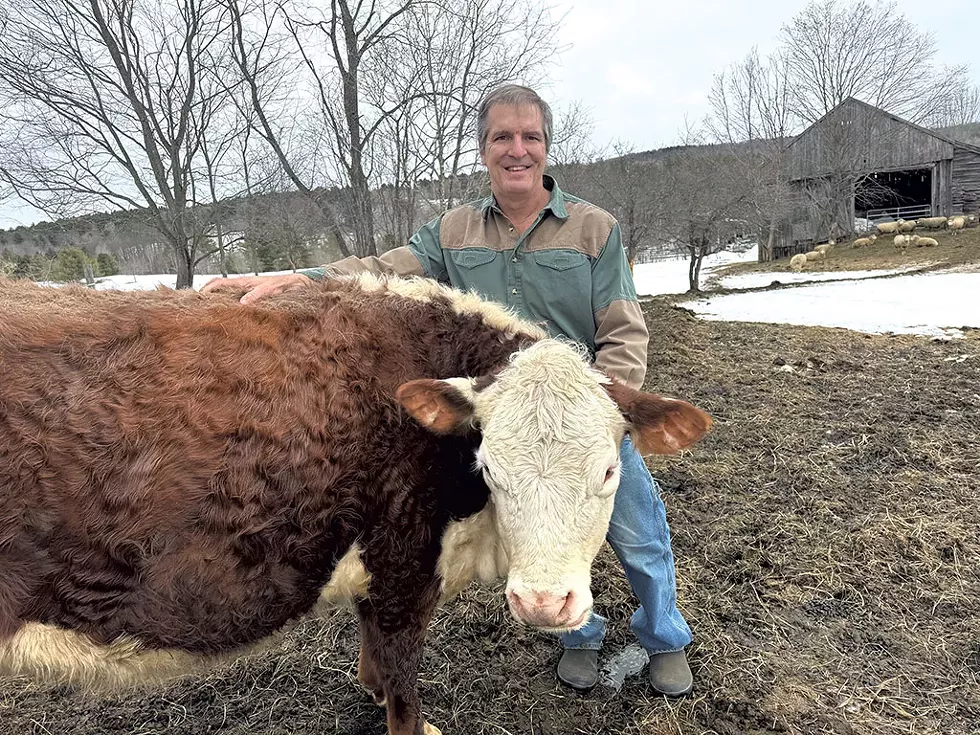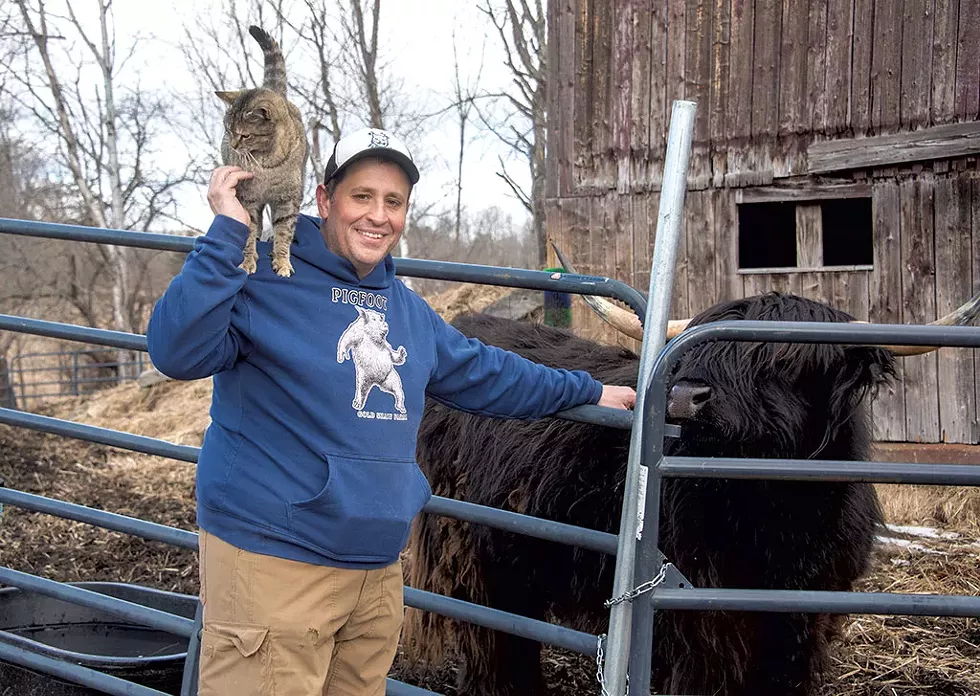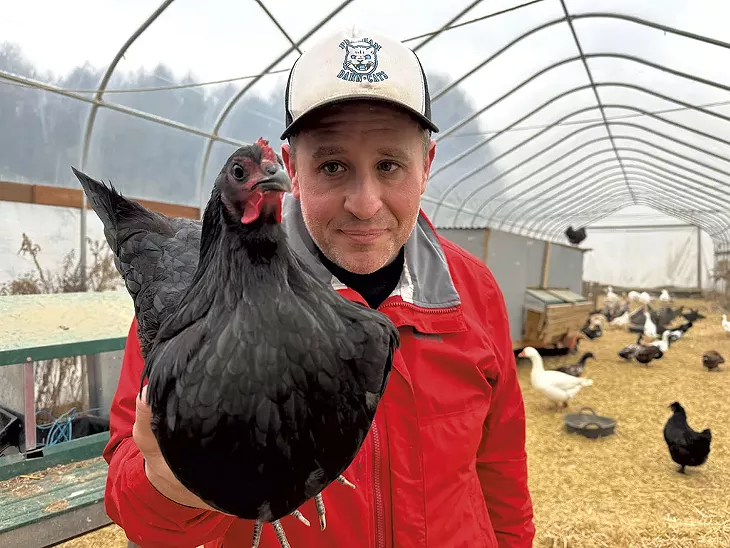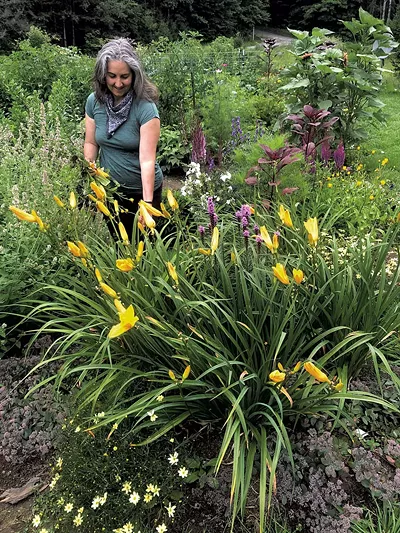Beaver was on the lunch menu at the Roy house.
In late February, Brad Roy stood over an electric meat grinder in the kitchen of his family’s Middlesex home. Sporting a reddish-brown beard and green “Horse Drawn Maple” baseball cap, he fed in salt pork, bacon and meat from a beaver that he’d trapped, skinned and gutted himself. As he worked, Brad said he dreamed of one day owning a smokehouse, and his wife, Alexa, proudly recounted the time she convinced her vegetarian friend to eat moose. Alexa filmed with her phone as the gooey pink mixture churned through the machine and plopped wetly into a gray plastic bin on the counter. She quickly uploaded the video to the couple’s Instagram account, @vtmillennialhomesteaders, captioning it “beaver burger” with a drooling emoji.
Brad formed the ground meat into patties and cooked them on a skillet in bacon grease, filling the kitchen with the smoky, rich scent of sizzling meat. The couple served the burgers with ramps — a type of wild onion that Alexa pickled in maple vinegar — diet Pepsi and hamburger buns from Shaw’s.
“We didn’t have time to make sourdough,” Brad sarcastically told a visiting reporter before digging in. “Sorry.”
Though the Roys may reluctantly head to the grocery store from time to time, their diet mostly consists of food sourced much closer to home. A typical dinner might include steaks from a deer shot within walking distance of the house, asparagus from the garden and freshly dug potatoes.
The native Vermonters — Alexa, 32, is from Manchester, and Brad, 30, is from Waterbury Center — spend much of their time tending to the vegetable garden on their two-acre homestead, raising chickens for meat and eggs in a backyard coop, tapping maple trees in nearby woods, and hunting for deer and moose. Over the past year, the couple have accumulated hundreds of pounds of meat, which they’ve butchered themselves and stored in a large freezer in their garage. Alexa enjoys experimenting with fermentation, filling mason jars with creations such as pickled eggs and “tomato wine,” which supposedly tastes like Chardonnay.
The Roys’ house, a modest raised ranch with an American flag out front, might fit in any suburban cul-de-sac. But the couple’s lifestyle seems like that of a bygone era, before the advent of strip malls and same-day shipping. The Roys are part of a new generation of Green Mountain homesteaders who are embracing self-reliance by growing and preserving their own food — at least as much as they can. Like their hippie predecessors, modern homesteaders come to the lifestyle for a variety of reasons, some ideological or religious, some environmental or health related, and some just to escape the rat race.
In the 1960s and ’70s, droves of city dwellers — often affluent and well educated — moved to rural places to drop out of mainstream American society. Back-to-the-landers, as they were called, often lived on small, rustic farms or communes, seeking simpler lives away from consumerism and traditional institutions. That counterculture movement was especially prevalent in Vermont, where its impact still reverberates in everything from state politics to farming.
Vermont’s new breed of homesteaders also encompasses a spectrum of cultural backgrounds and political beliefs, as well as varying degrees of adherence to homesteading principles. What unites them is the shared idea that old-school self-reliance can be at least a salve, if not always a cure, for modern ills.
“I like being able to do stuff on our own and not rely on so much from others or from the system,” Alexa said. “Things could not be available at some point. We never know. I mean, look at the egg shortage.”
For Alexa, that mindset runs in the family. Her grandparents were subsistence farmers, and her parents continued the tradition through gardening. Brad grew up hunting and fishing, and he fondly remembers his feeling of wonder when he discovered he could walk into the woods and come back with dinner. As adults, the couple started a small garden outside a one-bedroom apartment in Waterbury in 2018. When they bought their home in Middlesex a year later, they became full-fledged homesteaders.
Unlike the original back-to-the-landers, however, modern-day homesteaders must reckon with what it means to live autonomously in an increasingly interconnected world. For the Roys and others, this can mean sacrificing ideological consistency in favor of practicality, such as working full-time jobs and making occasional, grudging trips to the grocery store.
By day, Brad works as a source water specialist for the Vermont Rural Water Association, and Alexa is a nurse at Central Vermont Medical Center’s integrative family medicine practice in Montpelier. They post homesteading content several times a week to Instagram, where the couple have amassed more than 11,000 followers — a sizable total for Vermont, though relatively modest in the booming world of homesteading social media influencers.
Still, the Roys’ IG bio does include a link to an Amazon store, where followers can buy various homesteading supplies the couple recommend — seed kits, a book titled How to Speak Chicken, wireless Bluetooth earbuds categorized under “Tools for the common homesteader.” The Roys haven’t made a single sale — a fact Brad chalks up to lack of advertising, because overt marketing “feels tacky.”
For the Roys and others, homesteading in the digital age feels a little like stepping into a malfunctioning time machine. Modern homesteaders raise chickens but track egg production through an app on their smartphone; they craft candles from beeswax but buy wicks on Amazon Prime. Today, complete independence from modern infrastructure is rarely feasible.
At the Roys’ kitchen table, Brad raised a glass. “Cheers,” he toasted. He took a swig of diet Pepsi and bit into his beaver burger. I took a bite and chewed slowly, hoping for something unusual. Alas, it tasted like regular beef.
Radically Local
On a recent Thursday afternoon, Taylor Barnes dumped food scraps from bright orange Home Depot buckets into a growing compost pile in her backyard in Pomfret. Wearing gardening gloves, a jean jacket, feather-shaped earrings and a gray knit hat, the 34-year-old dance teacher gestured to store-bought grapes and baby carrots among the earthy-smelling muck.
“See? We’re not zero-waste. We’re not perfect,” she said, then added, “Well, I guess it all goes back to the earth.”
Taylor is still getting used to the luxury of a backyard to call her own. Not long ago, she and her husband, Tatum, lived in a cramped 350-square-foot studio in Brooklyn. Back then, composting was a much different ordeal: They’d store food scraps in their freezer and haul them to a drop-off every other week at the local farmers market.
Composting wasn’t the only challenge of city life. In Brooklyn, after a tiring day of work as a substitute teacher, Taylor would put on headphones and pull up her hood for the bus ride home, then collapse into bed, only to repeat the cycle the next day. Tatum also worked as a teacher, at what he called a “bougie” private school in Brooklyn. The couple, who met as students at Williams College, began to feel as though all of their time fell into one of two categories: working or recovering from work.
“Something was chafing my soul,” Tatum said of life in New York City. “It felt so existentially off-putting.”
The election of Donald Trump in 2016 deepened their sense of disillusionment, and the COVID-19 lockdowns in 2020 were the final push they needed to leave the city. That year, the couple relocated to an apartment in Wilder, Vt. A year later, they purchased a 670-square-foot fixer-upper in Pomfret for $160,000, on two and a half acres of land that they dubbed Full Joy Farm. Homesteading in rural Vermont felt like a way out, a chance to reconnect with nature and, as Taylor put it, “pull away from capitalist ambitions.”
The Barneses are part of a larger homesteading movement accelerated by the pandemic. A survey of 3,000 people in Maine and Vermont found that the number of northern New Englanders engaging in some form of home food production after the pandemic more than doubled, from 32 percent of respondents in 2020 to 68 percent in 2022.
But this wave of back-to-the-land interest was part of a much older pattern. In the 1930s and ’40s, Vermont saw an influx of newcomers, spurred by the economic upheaval of the Great Depression. The “hippie invasion” of the 1960s and ’70s, fueled by the strife of the Vietnam War, the Civil Rights Movement and growing distrust of government, spiked Vermont’s population by 14 percent in the 1960s and another 15 percent in the 1970s.
“Financial panics, depressions, crises like that are always the trigger,” said Dona Brown, professor emerita of history at the University of Vermont and author of Back to the Land: The Enduring Dream of Self-Sufficiency in Rural America. “I think the reasons were very much the same: This feeling of I’m out of control. I’m afraid for the future. It pisses me off that I can’t control any part of my life.”
But as the Barneses have discovered, homesteading is anything but a quick fix to modern malaise. When they started out, they bought seven chickens, but a raccoon killed them all. Undeterred, they salvaged the few eggs that had been laid, incubated them, raised the chicks and built a raccoon-proof coop — only for a weasel to break in and kill the next generation. After that, they gave up on raising animals and decided to focus on gardening and caring for their newborn instead. But growing crops such as broccoli and cauliflower also proved challenging: The plants never seemed to stay upright.
“I originally felt a lot of aesthetic appeal for certain things and didn’t realize, Oh, wow, this is what goes on behind the scenes,” Taylor said. “Like, it’s not just a social media thing.”
These days, about 90 percent of the Barneses’ produce comes from their garden, including potatoes, cucumbers, tomatoes, kale, chard, apples and gooseberries. The intentionally unmanicured backyard has a small brook that trickles through thick growths of invasive knotweed. But they keep one patch mowed: a small campsite, which the Barneses advertise through a site called Hipcamp for $24 on weeknights and $30 on weekends. Soon to come: a renovated camper van with a working sink, for which they’ll charge $60.
But those rentals don’t pay the bills, and the Barneses still work full-time jobs. Tatum is a recreation specialist at Hartford Parks & Recreation and the director of spiritual exploration at North Chapel, a Unitarian Universalist church in Woodstock. Taylor teaches dance and works at New Suns Community Center in North Thetford, a gathering space for people of color living in rural Vermont.
“We’re not existing outside of capitalism,” Taylor said. “I mean, ideologically, yes, but in our lives, no.”
Living Right
John Klar grew up hearing stories from his grandmother about the Great Depression. After a bank run wiped out her savings, she foraged for food and relied on the generosity of neighboring farmers to get by. Even in her nineties, Klar recalled, she kept up old habits, collecting beechnuts, fishing for trout and picking berries. She always kept at least a couple weeks’ worth of food in the house.
Those stories have stayed with Klar. The 61-year-old seventh-generation Vermonter has homesteaded since the late 1990s. Sitting at the kitchen table in his Brookfield home recently, he pondered the many ways the world could fall apart. A sign reading “Relax, God is in Control,” hung on his wall. Klar said he worries about such cinematic catastrophes as World War III, another pandemic, civil war, a natural disaster or an asteroid hitting the Earth. He insists he isn’t overly paranoid.
“It’s a win-win. Because if the world collapses, I have food. If the world doesn’t collapse, I have food,” Klar said.
Klar’s foray into homesteading began two decades ago, when he was working as a criminal defense attorney in Storrs, Conn. In his mid-thirties, he fell ill with Lyme disease and fibromyalgia, a chronic condition that causes widespread musculoskeletal pain. In just a few months, Klar went from being an avid backpacker and outdoorsman to struggling to carry groceries. At times, Klar recalled, the pain was so intense he could barely walk. He prayed for the first time, wishing for his own death. According to Klar, his pain disappeared with that prayer, and he became a devout Christian.
With newfound conviction and in search of a drastic lifestyle shift, Klar closed his law practice. He and his wife, Jackie — who works as a nurse and ran for Vermont’s House of Representatives in 2022 — bought a 160-acre dairy farm in the Northeast Kingdom town of Barton in 1999. One day, Klar looked at the dinner table and realized that everything on it came from the farm: milk from the family’s cows, butter churned by hand, chickens raised and butchered on-site, and vegetables and potatoes grown on their land.
“It was all better than anything in the store. The chicken was more tender, more flavorful. We knew the animal had been treated well,” Klar said. “Everything about it was an epiphany.”
In 2005, the Klars moved to Irasburg, where they raised beef and sheep, then to their current residence in Brookfield in 2016. Today, on their remote farm miles down winding dirt roads, Klar spends much of his days tending to animals.
On a recent Wednesday, he fed his 33 sheep and two rams a bale of sweet-smelling hay as his border collie trailed close behind, its paws coated in mud from the wet, manure-dotted ground. With the affection of a doting parent, he gently petted the sheep as they bleated. “This is Muffin. Hi, Muffin!” he said in a high-pitched tone. “John Klar for State Senate” signs hung upside down in the windows of the weathered wooden barn.
To Klar, “dependent” is a dirty word. A small sampling of beliefs he rattled off that afternoon: Vermont imports too much out-of-state food. Vermont’s economy is too dependent on tourism. Americans are too dependent on the “welfare state.” In the lead-up to the Irish potato famine, people were too dependent on one kind of potato.
Yet Klar isn’t fully self-reliant. He supports himself through a payout from a disability insurance policy, as well as writing freelance and for a Substack newsletter. The farm business, selling lambs, roughly breaks even.
Klar says he increasingly sees Republicans, not Democrats, aligning with values of self-sufficiency. And like many voters, he believes Democrats have abandoned the working class and sided with corporate interests — starting with Wall Street bailouts after the 2008 recession. Klar sees this corporate influence extending to food and agriculture, too, railing against politicians’ support for genetically modified organisms and multinational giants such as the corporation formerly known as Monsanto.
Klar ran as a Republican for Vermont governor in 2020 and state senator in 2022, making headlines for his controversial focus on culture war issues such as critical race theory and transgender rights. He lost both elections but remains committed to another cause: getting conservatives to support small farms and consume fresh food, bucking the stereotype that “conservatives eat Chick-fil-A,” he said.
The former Bernie Sanders supporter and two-time Barack Obama voter most recently voted for Trump and is a passionate supporter of U.S. Health Secretary Robert F. Kennedy Jr.’s “Make America Healthy Again” platform. In many ways, Klar’s evolution is emblematic of a broader political realignment: Homesteading, once deeply tied to left-wing movements, is now increasingly embraced by those on the right.
In the ’60s and ’70s, homesteading in Vermont was “totally associated with the left,” according to Brown, the historian. But back-to-the-land liberals always had “a strong decentralist tendency,” she said, meaning they advocated for shifting power from the federal government to local entities. That distrust of big government can be found on both sides of the political spectrum, in a horseshoe alliance of the far right and far left.
“What’s the difference between an anarchist and a libertarian?” Brown asked. “Maybe not that much.”
Peace, Love and Capitalism
“Look how big Samson is. He is a big, big duck. This is a duck, folks. This is not a goose,” Morgan Gold said into the camera. “I mean, good golly, look how big he is!”
Wearing an orange knit beanie and navy zip-up hoodie, Gold held up the squirming, behemoth bird. The 2020 Gold Shaw Farm YouTube video, titled “Our Freakishly Huge Duck (This is not NORMAL.),” received 2.5 million views.
A decade ago, the Peacham farmer couldn’t have imagined that his day job would involve gushing about the size of a waterfowl. Back then, he was working as chief marketing officer at an investment company in Washington, D.C.
“It had been my dream job, the thing I’d been working towards,” said Gold, 45. “And I was realizing, Oh, I’m just working for another person. I don’t have freedom. I don’t have control. And so I got really kind of depressed.”
Gold started going to farmers markets, gardening and reading up on regenerative agriculture. In 2016, he and his wife, Allison, bought a historic property on a 160-acre Peacham farm, for $350,000 in cash, as a second home.
Six months later, the couple decided to move there full time. Gold took a job at the insurance company National Life Group in Montpelier, cutting his C-suite salary in half. That same year, he bought 40 ducks. He planned to sell their eggs to supplement his income, and he began documenting his duck-related adventures online.
He soon learned a hard truth: His ducks had more monetary value looking cute on the internet than for the eggs they laid. In 2020, Gold told the New York Times he was earning $2,500 to $4,000 a month from YouTube advertising — about eight times what he made from selling farm products.
In 2022, he quit his day job at National Life and went all in on farm content creation. Today, Gold has more than 5 million followers across YouTube, TikTok and Facebook. His audience, as he has surmised from his comment sections, consists of mostly suburban and urban dwellers. He is sponsored by brands such as Nutro dog food and Magic Spoon cereal, sells Gold Shaw Farm-branded T-shirts, wrote a children’s book about his dog Toby, and is currently writing a memoir.
“If it was just the farm, I would have failed miserably, financially,” Gold said. “I try to be wicked transparent about that, because I think sometimes people see, Wow, this guy’s got some ducks and some cows, and he’s able to make it all work. I want that life. And it’s like, It’s not that easy.”
Marketing comes easier to Gold, who is a natural on camera. He has a short, sturdy build, an approachable vibe and often sports a baseball cap. Videos typically begin with Gold greeting his animals with the enthusiasm of a kid on Christmas morning. He delivers his signature line, “Release the quacken!” as the ducks waddle out.
Gold then delights viewers by sharing his latest farm disaster and how he miraculously bounced back. A recent highlight: “MISSING PIG DISCOVERED: Thermal Drone Finds ‘Pigfoot’ After 7 MONTHS!” The April Fools’ Day, Blair Witch Project-style video captures Gold’s dramatic search for his missing pig. He scours the woods around his farm, where he comes face-to-face with a mysterious creature that he fears has become a feral hog. (If you can’t get enough of “Pigfoot,” you’re in luck — Gold sells a T-shirt on the website Fourthwall depicting the pig on his hind legs for as low as $25. Naturally.)
Gold has come to understand that in today’s world, living solely off the land isn’t financially sustainable. Homesteaders must find other ways to support their ventures and, in the spirit of late-stage capitalism, often do so by commercializing homesteading itself. The ironic result: What was once seen as an anti-consumerist lifestyle has become a way to sell more stuff, from the latest farm gadgets to expensive courses teaching others how to live out their rural fantasies.
Economic trends have exacerbated those pressures. While gardening can help reduce grocery expenses, whoever said “growing your own food is like printing your own money” likely overlooked the significant capital costs involved. And students of economics would caution homesteaders to consider opportunity cost, including the value of their labor.
Last year, Gold profited about $15,000 from his farm business, including selling tree seedlings, catnip, pork, and geese for meat and eggs. He calculated that his work on the farm came out to a wage of $12.24 per hour, a number far dwarfed by his profit from content creation.
Consider, too, that while food prices may feel inflated now, in 1901 the average household spent a whopping 40 percent of its budget on food, according to Brown, the historian. In 2023, data from the U.S. Department of Agriculture showed that households spent about 13 percent of their disposable income on groceries. As supermarkets have made food increasingly more affordable and accessible, homesteading no longer offers the same bang for its buck.
The result: Many homesteaders, like Gold, are turning to online content creation to subsidize their 19th-century lifestyles. Perhaps the most well-known figure in this space is Hannah Neeleman, who runs the account Ballerina Farm, to the tune of 10 million followers on Instagram. The Juilliard-trained dancer, mom of eight, devout Mormon and prairie-core fashionista posts videos of aesthetic homemaking on her farm in Utah. Content creation is likely not the only way the family supports its lifestyle: Neeleman’s father-in-law happens to be the founder of JetBlue airlines.
The Real Deal
For many Vermonters, the modern homesteading trend may bring to mind Scott and Helen Nearing — the original homesteading influencers. Scott, once an economics professor at the University of Pennsylvania’s Wharton School, lost his job after clashing with his colleagues over his critiques of wealth inequality and calls for child labor reform. In 1932, the Nearings abandoned their New York City apartment to start a new life on a farm in Jamaica, Vt. There, the couple wrote a guide to self-sufficiency called Living the Good Life. Originally published in 1954, it is practically the holy text of today’s homesteading movement.
But all was not as it seemed. In 2003, neighbor Jean Hay Bright published Meanwhile, Next Door to the Good Life, which revealed that the Nearings had come into significant inheritances and not supported themselves on cash crops, as they claimed.
“It is a real problem for a lot of people who are lower middle class, who have the dream of homesteading,” said Greg Joly, an advisory board member of the Good Life Center in Maine, a nonprofit that aims to continue the legacy of the Nearings. “I’ve seen people get really knotted up and in trouble because it’s hard to start out, and it’s hard to continue. I’ve seen it all the time, so I can understand the disillusionment.”
Today, homesteaders often find creative sources of income. For example, José and Stephanie Romero, New York City transplants who now run Maple Mountain Homestead in Milton, also host an Airbnb in their backyard advertised as “perfect for travelers curious about homestead living.” The roughly 300-square-foot geodome, with a woodstove and nearby compost toilet, goes for $115 a night. The Romeros also host Homestead Learning Days, workshops where novices can learn skills such as how to maintain a garden, dehydrate herbs and make homemade cider.
“We want people who aren’t sure if they want to get into this lifestyle to see if they can do it. It’s pretty much like fancy camping,” Stephanie said, later adding, “It definitely helps in diversifying income.”
Calais resident Teri Page wants to help people understand the realities of homesteading before jumping on social media trends. She runs a blog called Homestead Honey, with posts such as “9 Reasons NOT to Build a Homestead from Scratch” (reasons include “You’re Not 100% All-In” and “A Bed Under Your Head”); instructions for butchering pigs, complete with photos of bloody carcasses; and a guide to living without running water.
A tab on the blog is devoted to finances, where Page explains that she’s able to afford homesteading through selling her books, including Creating Your Off-Grid Homestead and The Backyard Bread & Pizza Oven; selling ad space on her blog; and offering coaching to women looking for help with homesteading. She also currently works as director of admissions at the Orchard Valley Waldorf School in East Montpelier.
“People get frustrated. You start down the road and then you realize, Oh, this is more expensive, or, Oh, maybe I need to work a job,” Page said. “Is that selling out? No, of course it’s not selling out. It’s what you have to do. It’s reality.”
Page, 52, considers herself among a more hard-core subset of homesteaders. Her husband, Brian, started building their off-grid wooden cabin from scratch on an eight-and-a-half-acre plot of land off a dirt road in Calais in 2020. During construction, the family of four, plus their two cats, lived in a tiny yurt in the backyard for four years, using an outhouse for a restroom. Before that, they lived off-grid in rural La Plata, Mo., where Page raised cows, ducks, chickens, pigs and sheep and homeschooled her kids. She described it as a magical time, when her kids had the freedom to run barefoot and spend their days caring for animals.
Originally from a suburb of Boston, Page was drawn to homesteading primarily for environmental reasons and a desire to feel connected to her food. During a period in her twenties, she ate only what she grew. As she’s gotten older, though, she’s become a bit more posh: Her house now has a bathroom with running water, and she purchases protein rather than raising meat herself.
“I still shop at the co-op,” Page said in between sips of tea with raw honey and a splash of raw milk from a nearby farm. “I shop at Shaw’s, too, when I need to. I’m not a purist, because I can’t be.”
Page has also started to pull back from blogging and said she’s uncomfortable with how social media algorithms prioritize clickbait over substance. She differentiates between what she calls “homesteading in the media” — an often-romanticized version of rural living — and “homesteading the lifestyle,” a way of life that’s far more rough-and-tumble. See: Meghan Markle’s latest Netflix series, “With Love, Meghan,” which shows the Duchess of Sussex harvesting fresh herbs, making homemade fruit preserves and collecting honey from a beehive.
The Roys share similar concerns. Brad has considered posting a video demonstrating how to slaughter a chicken, but it would likely run afoul of content rules prohibiting graphic violence. Footage of that same chicken enjoying a sunny day, however, would get likes and shares.
While Gold sometimes feels odd about acting as a salesman, he enjoys the social media performances that fuel his bucolic lifestyle. In a recent video, titled “How Much Money My Small Farm Made This Year,” he reflected on the disappointment that his farm wasn’t earning as much as he hoped. But he said he refused to quit, reminding his audience how much he cherished waking up to farm animals each morning.
“If I won the lottery tomorrow … I’d pretty much be living my life the same way,” Gold said in the video. “With maybe slightly fancier equipment.”

